YAMAHA RHINO 700 2013 Workshop Manual
Manufacturer: YAMAHA, Model Year: 2013, Model line: RHINO 700, Model: YAMAHA RHINO 700 2013Pages: 188, PDF Size: 4.9 MB
Page 51 of 188
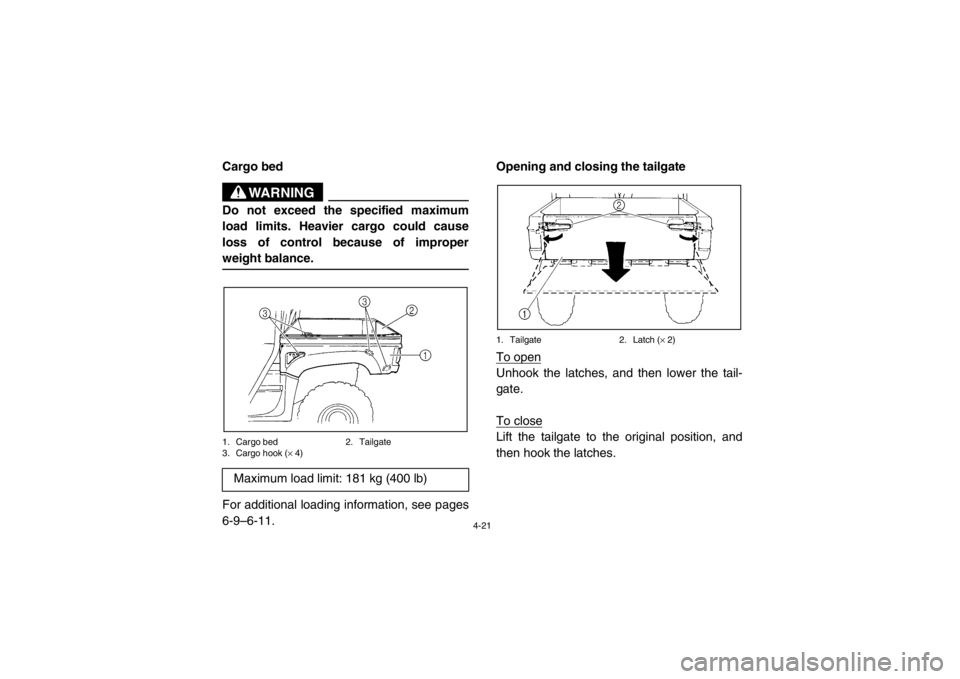
4-21
EVU00351Cargo bed
WARNING
Do not exceed the specified maximum
load limits. Heavier cargo could cause
loss of control because of improper
weight balance.1. Cargo bed2. Tailgate
3. Cargo hook ( × 4)For additional loading information, see pages
6-9–6-11. Opening and closing the tailgate
1. Tailgate
2. Latch (× 2)To openUnhook the latches, and then lower the tail-
gate.
To closeLift the tailgate to the original position, and
then hook the latches.
Maximum load limit: 181 kg (400 lb)
1RB7A_EE.book Page 21 Tuesday, April 24, 2012 9:07 AM
Page 52 of 188
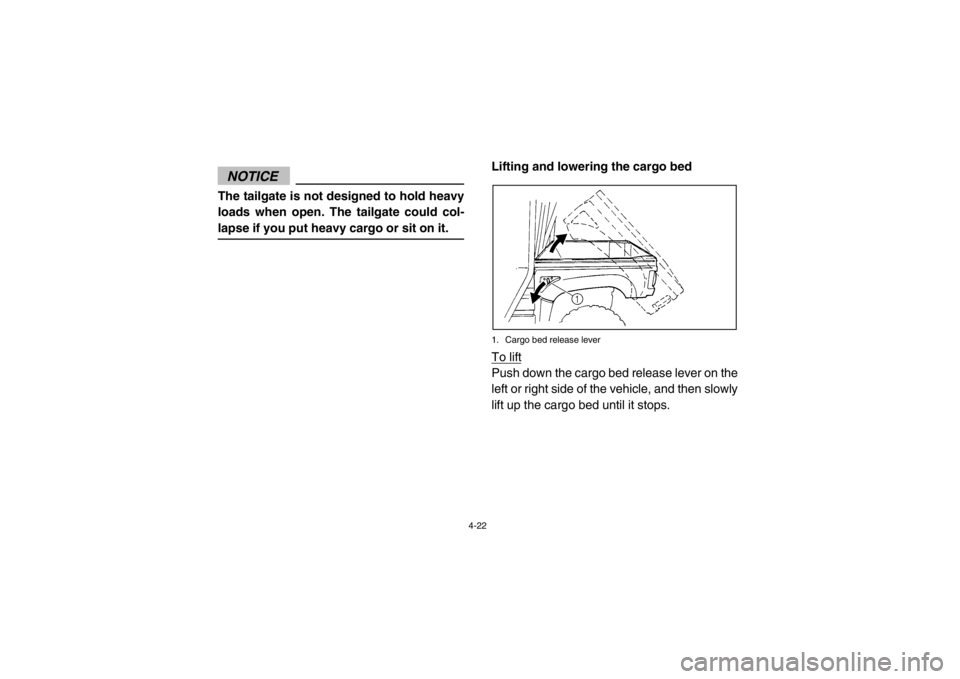
4-22
NOTICEThe tailgate is not designed to hold heavy
loads when open. The tailgate could col-
lapse if you put heavy cargo or sit on it.
Lifting and lowering the cargo bed1. Cargo bed release leverTo liftPush down the cargo bed release lever on the
left or right side of the vehicle, and then slowly
lift up the cargo bed until it stops.
1RB7A_EE.book Page 22 Tuesday, April 24, 2012 9:07 AM
Page 53 of 188
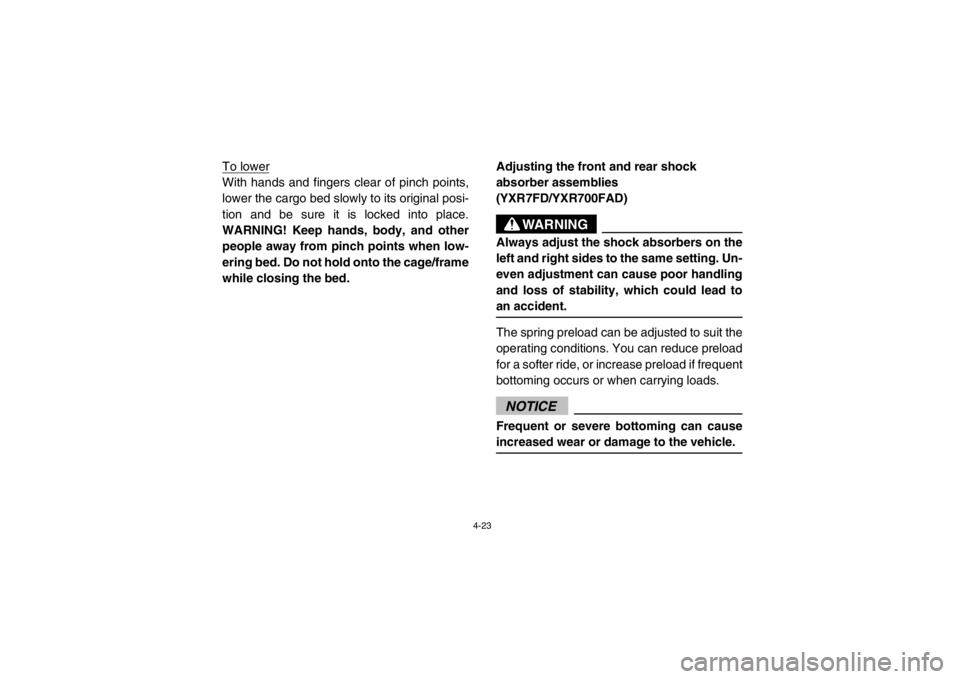
4-23
To lowerWith hands and fingers clear of pinch points,
lower the cargo bed slowly to its original posi-
tion and be sure it is locked into place.
WARNING! Keep hands, body, and other
people away from pinch points when low-
ering bed. Do not hold onto the cage/frame
while closing the bed.
5B410006Adjusting the front and rear shock
absorber assemblies
(YXR7FD/YXR700FAD)
WARNING
Always adjust the shock absorbers on the
left and right sides to the same setting. Un-
even adjustment can cause poor handling
and loss of stability, which could lead to
an accident.The spring preload can be adjusted to suit the
operating conditions. You can reduce preload
for a softer ride, or increase preload if frequent
bottoming occurs or when carrying loads.NOTICEFrequent or severe bottoming can cause
increased wear or damage to the vehicle.
1RB7A_EE.book Page 23 Tuesday, April 24, 2012 9:07 AM
Page 54 of 188
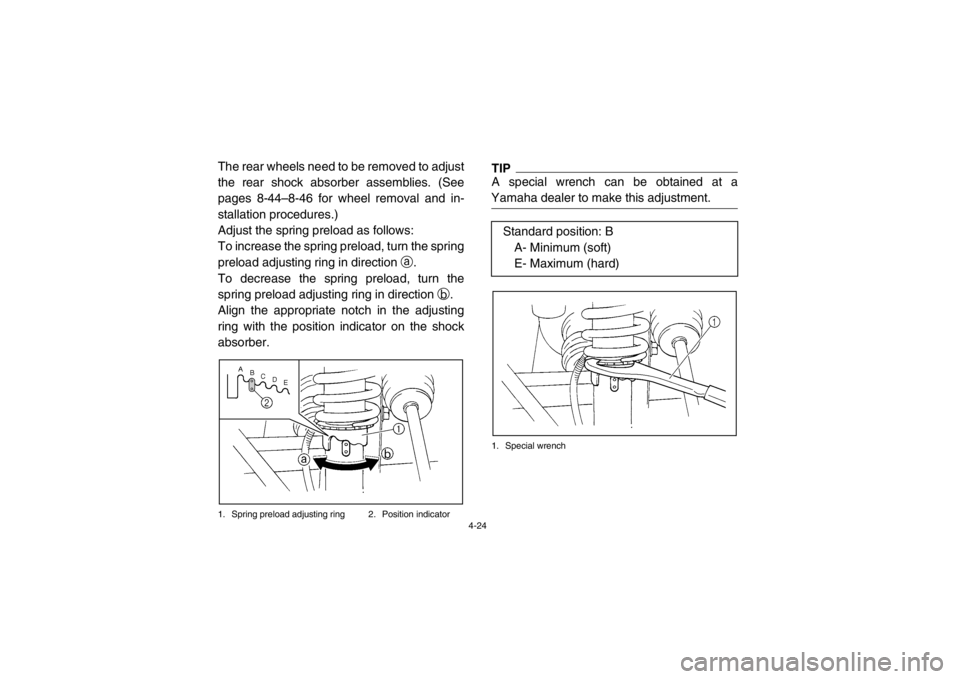
4-24
The rear wheels need to be removed to adjust
the rear shock absorber assemblies. (See
pages 8-44–8-46 for wheel removal and in-
stallation procedures.)
Adjust the spring preload as follows:
To increase the spring preload, turn the spring
preload adjusting ring in direction a.
To decrease the spring preload, turn the
spring preload adjusting ring in direction b.
Align the appropriate notch in the adjusting
ring with the position indicator on the shock
absorber.1. Spring preload adjusting ring 2. Position indicator
TIPA special wrench can be obtained at a
Yamaha dealer to make this adjustment.1. Special wrench
Standard position: B A- Minimum (soft)
E- Maximum (hard)
1RB7A_EE.book Page 24 Tuesday, April 24, 2012 9:07 AM
Page 55 of 188
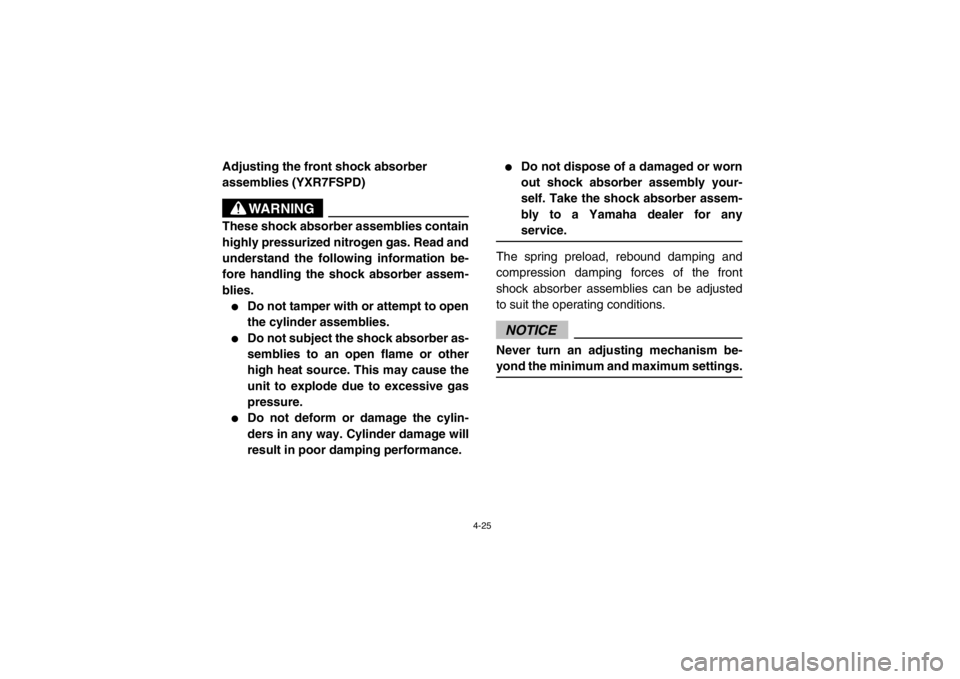
4-25
5UG1B001 Adjusting the front shock absorber
assemblies (YXR7FSPD)
WARNING
These shock absorber assemblies contain
highly pressurized nitrogen gas. Read and
understand the following information be-
fore handling the shock absorber assem-
blies.●
Do not tamper with or attempt to open
the cylinder assemblies.
●
Do not subject the shock absorber as-
semblies to an open flame or other
high heat source. This may cause the
unit to explode due to excessive gas
pressure.
●
Do not deform or damage the cylin-
ders in any way. Cylinder damage will
result in poor damping performance.
●
Do not dispose of a damaged or worn
out shock absorber assembly your-
self. Take the shock absorber assem-
bly to a Yamaha dealer for any
service.
The spring preload, rebound damping and
compression damping forces of the front
shock absorber assemblies can be adjusted
to suit the operating conditions. NOTICENever turn an adjusting mechanism be-
yond the minimum and maximum settings.
1RB7A_EE.book Page 25 Tuesday, April 24, 2012 9:07 AM
Page 56 of 188
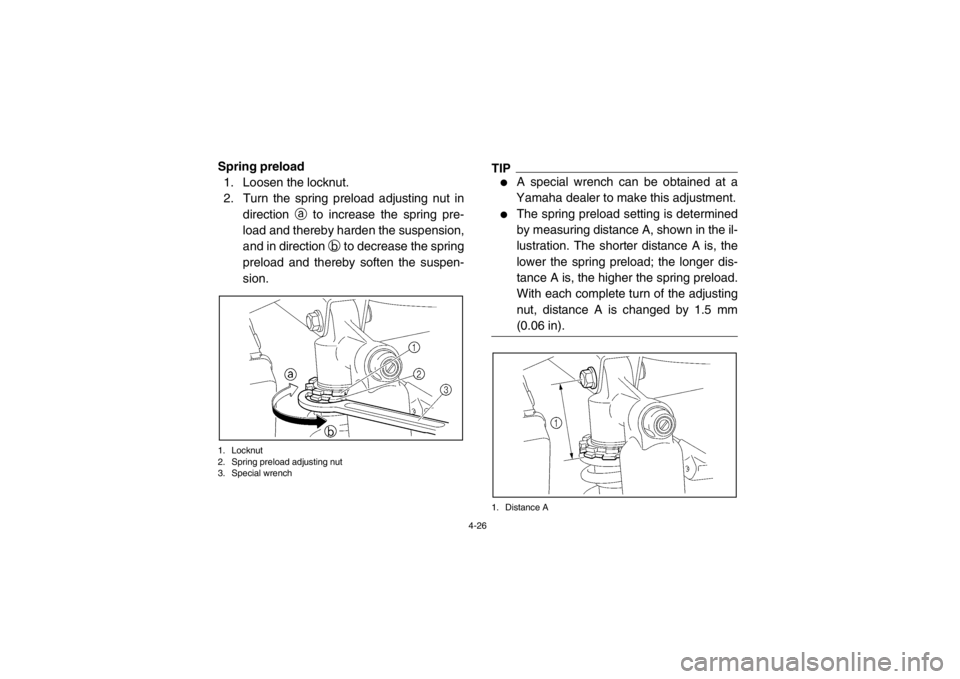
4-26
Spring preload1. Loosen the locknut.
2. Turn the spring preload adjusting nut in direction a to increase the spring pre-
load and thereby harden the suspension,
and in direction b to decrease the spring
preload and thereby soften the suspen-
sion.1. Locknut
2. Spring preload adjusting nut
3. Special wrench
TIP●
A special wrench can be obtained at a
Yamaha dealer to make this adjustment.
●
The spring preload setting is determined
by measuring distance A, shown in the il-
lustration. The shorter distance A is, the
lower the spring preload; the longer dis-
tance A is, the higher the spring preload.
With each complete turn of the adjusting
nut, distance A is changed by 1.5 mm
(0.06 in).
1. Distance A
1RB7A_EE.book Page 26 Tuesday, April 24, 2012 9:07 AM
Page 57 of 188
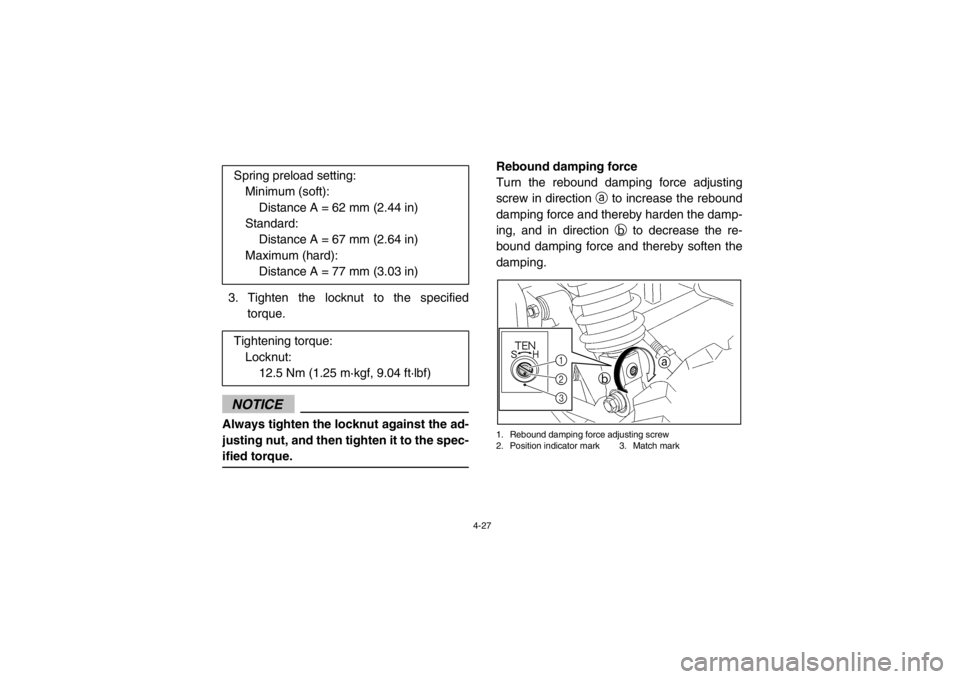
4-27
3. Tighten the locknut to the specifiedtorque.NOTICEAlways tighten the locknut against the ad-
justing nut, and then tighten it to the spec-
ified torque.
Rebound damping force
Turn the rebound damping force adjusting
screw in direction a to increase the rebound
damping force and thereby harden the damp-
ing, and in direction b to decrease the re-
bound damping force and thereby soften the
damping.1. Rebound damping force adjusting screw
2. Position indicator mark 3. Match mark
Spring preload setting: Minimum (soft):
Distance A = 62 mm (2.44 in)
Standard: Distance A = 67 mm (2.64 in)
Maximum (hard): Distance A = 77 mm (3.03 in)
Tightening torque: Locknut: 12.5 Nm (1.25 m·kgf, 9.04 ft·lbf)
123 b
a
1RB7A_EE.book Page 27 Tuesday, April 24, 2012 9:07 AM
Page 58 of 188
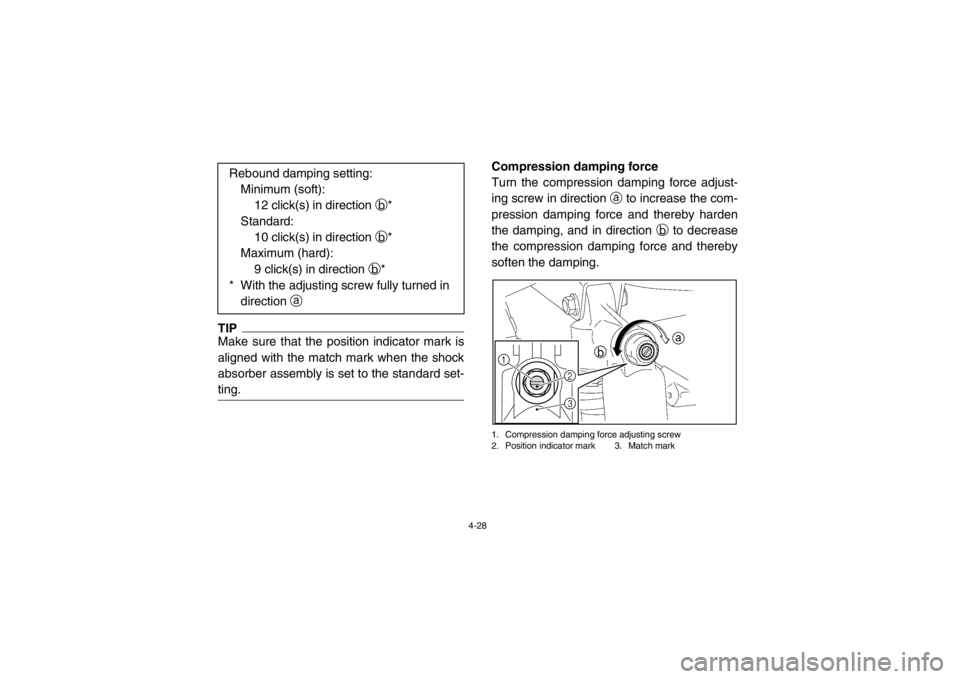
4-28
TIPMake sure that the position indicator mark is
aligned with the match mark when the shock
absorber assembly is set to the standard set-
ting.
Compression damping force
Turn the compression damping force adjust-
ing screw in direction a to increase the com-
pression damping force and thereby harden
the damping, and in direction b to decrease
the compression damping force and thereby
soften the damping.1. Compression damping force adjusting screw
2. Position indicator mark 3. Match mark
Rebound damping setting:
Minimum (soft): 12 click(s) in direction b*
Standard: 10 click(s) in direction b*
Maximum (hard):
9 click(s) in direction b*
* With the adjusting screw fully turned in direction a
1
3 2
1RB7A_EE.book Page 28 Tuesday, April 24, 2012 9:07 AM
Page 59 of 188

4-29
TIPMake sure that the position indicator mark is
aligned with the match mark when the shock
absorber assembly is set to the standard set-
ting.
TIPAlthough the total number of clicks of a damp-
ing force adjusting mechanism may not exact-
ly match the above specifications due to small
differences in production, the actual number
of clicks always represents the entire adjust-
ing range. To obtain a precise adjustment, it
would be advisable to check the number of
clicks of each damping force adjusting mech-
anism and to modify the specifications as nec-
essary.
Compression damping setting:Minimum (soft): 12 click(s) in direction b*
Standard: 10 click(s) in direction b*
Maximum (hard):
9 click(s) in direction b*
* With the adjusting screw fully turned in direction a
1RB7A_EE.book Page 29 Tuesday, April 24, 2012 9:07 AM
Page 60 of 188
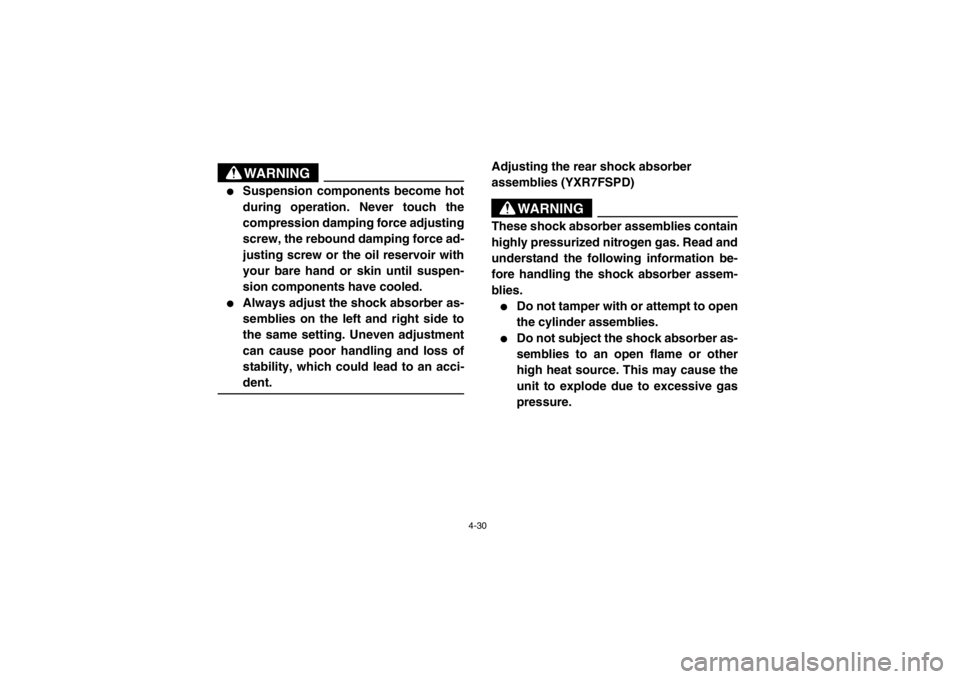
4-30
WARNING
●
Suspension components become hot
during operation. Never touch the
compression damping force adjusting
screw, the rebound damping force ad-
justing screw or the oil reservoir with
your bare hand or skin until suspen-
sion components have cooled.
●
Always adjust the shock absorber as-
semblies on the left and right side to
the same setting. Uneven adjustment
can cause poor handling and loss of
stability, which could lead to an acci-
dent.
5UG1B002Adjusting the rear shock absorber
assemblies (YXR7FSPD)
WARNING
These shock absorber assemblies contain
highly pressurized nitrogen gas. Read and
understand the following information be-
fore handling the shock absorber assem-
blies.●
Do not tamper with or attempt to open
the cylinder assemblies.
●
Do not subject the shock absorber as-
semblies to an open flame or other
high heat source. This may cause the
unit to explode due to excessive gas
pressure.
1RB7A_EE.book Page 30 Tuesday, April 24, 2012 9:07 AM